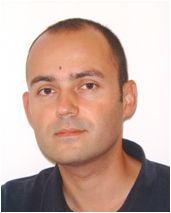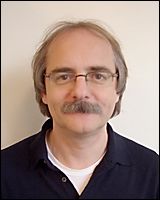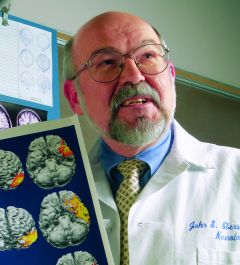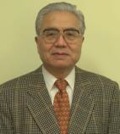INVITED SPEAKERS AND TITLES
(1) Prof. Fabrice Wendling, Universite de Rennes, France
(2) Prof. Jean Gotman, McGill University, Canada
Combining EEG and fMRI to study the epileptic focus
(3) Prof. Christoph M. Michel, University Hospital of Geneva, Switzerland
Distributed Source Imaging of High Density EEG in Epilepsy
(4) Prof. Shoogo Ueno, Kyushu University, Japan
Biomagnetic and Neuromagnetic Approaches to the Study of Epilepsy
(5) Prof. Nobukazu Nakasato, Kohnan Hospital/Tohoku University, Japan
What's the difference between EEG and MEG in practice?
(6) Prof. Walter J. Freeman, UC Berkeley, U.S.A.
(7) Prof. John S. Ebersole, The University of Chicago, U.S.A.
Comparative and Combined MEG-EEG Source Modeling in Epilepsy Evaluations
(8) Prof. Michael Scherg, MEGIS Software GmbH, Germany
Source analysis of interictal spikes in EEG and MEG
(9) Prof. Toshimitsu Musha, Brain Functions Laboratory, Inc., Japan
Neuronal Abnormality Topography (NAT)

Fabrice WENDLING, Ph.D.
INSERM (National Institute of Health and Medical Research)
Realistic modeling and interpretation of depth-EEG signals recorded
during inter-ictal to ictal transition in temporal lobe epilepsy
Abstract:
Temporal lobe epilepsy (TLE) is one of the most common forms of partial epilepsy. It is characterized by recurrent seizures originating from one or several areas of the temporal cortex and propagating through interconnected neuronal networks within and outside the temporal lobe. Although there is current evidence that seizures are related to abnormal excessive firing and synchronization of neurons, little is known about the precise basic mechanisms underlying human epileptic seizures and mechanisms of transitions from normal to paroxysmal activity. This talk will present some insights into transition mechanisms to ictal activity in human TLE that can be drawn from a macroscopic modeling approach that developed over the three past decades. The term ‘macroscopic’ relates to the modeling level. Indeed, relevant variables in considered models describe the average activity of interconnected subpopulations of principal neurons and interneurons without explicit representation of mechanisms lying at the level of single cells, conversely to biologically-inspired detailed models. Although macroscopic, these models rely on neurophysiological data and have two essential features. First, their parameters relate to excitatory and inhibitory processes taking place in the considered neuronal tissue. Second, the temporal dynamics of their output is analogous to a field activity, allowing for direct comparison with real electroencephalographic signals recorded with intracerebral electrodes (depth-EEG, stereotaxic method) during presurgical evaluation of patients candidate to epilepsy surgery. During this presentation, a brief historical perspective about macroscopic models of EEG will be provided along with a short description of their theoretical bases. Then, a model-based interpretation of depth-EEG signals recorded in humans during the transition to ictal activity will be illustrated and discussed.
About the Speaker:
Fabrice Wendling is senior research scientist (Research Director) at Inserm (French National Institute of Health and Medical Research). He has been heading, since 2001, the “EPIC” team “Dynamics of neuronal systems in Epilepsy and Cognition” at the Laboratory of Signal and Image Processing, Inserm U642, in Rennes, France.
F. Wendling has been working in the field of biomedical signal analysis for twenty years. His team has developed a longstanding experience in brain signals analysis and physiological modeling of neuronal systems involved in the generation of electroencephalographic (EEG) observations. F. Wendling has been working on epilepsy for 15 years. He developed specific methods to analyse EEG signals (scalp and intracerebral), in close collaboration with clinicians. These include time-frequency/time-scale methods for non-stationary signals, linear (coherence based) and nonlinear (regression based) methods to study brain connectivity and matching techniques to assess reproducibility of electrophysiological patterns during epileptic seizures. In parallel, he has developed computational models (cellular and neuronal population level) of brain electrical activity generation. These models are specifically adapted to the cellular organization of structures predominantly involved in temporal lobe epilepsy (like hippocampus and entorhinal cortex) and are used to interpret local and global field potentials recorded from the epileptic brain during interictal and ictal periods. F. Wendling has authored/co-authored about 50 papers in peer-reviewed journals either with methodological or clinical scope. Complete CV can be found at http://perso.univ-rennes1.fr/fabrice.wendling/.

Jean GOTMAN, Ph.D.
Montreal Neurological Institute
McGill University
CANADA
Combining EEG and fMRI to study the epileptic focus
Abstract:
It is not easy to determine the location of the cerebral generators and the other brain regions that may be involved at the time of an epileptic discharge seen in the scalp EEG. The possibility to combine EEG recording with functional MRI scanning (fMRI) opens the opportunity to uncover the regions of the brain showing changes in metabolism and blood flow in response to epileptic discharges seen in the EEG. These regions presumably reflect the abnormal neuronal activity at the origin of epileptic discharges and involved in their propagation. We will discuss the methodological problems encountered when recording the EEG inside the MR scanner and issues related to the analysis of the MRI signal. We will then present the results obtained in patients with different types of focal epileptic disorders and in patients with primary generalized epilepsy. The results in general indicate that the source of epileptic discharges may often be identified but that these discharges also affect brain areas beyond the presumed region in which they are generated. If a seizure is recorded during the EEG-fMRI study, dynamic analysis allows the study of the seizure discharge from its very onset through its development. The non-invasive nature of this method opens new horizons in the investigation of brain regions involved and affected by epileptic discharges.
About the Speaker:
Dr. Jean Gotman is a Professor at the Montreal Neurological Institute of McGill University. He was trained as an electrical engineer in France, pursued a Master's in Computer Science, and holds a PhD degree in Neuroscience from McGill University. In 1972, Dr. Gotman began working on computerized EEG and epilepsy analysis. He has since been highly involved in the field of EEG data recording and analysis, including methods of automatic seizure detection and source analysis. More recently, his research interests have included imaging methods, such as combined EEG-fMRI recordings. Dr. Gotman has collaborated with other groups both within the MNI and from other universities.
In 1986 Dr. Gotman formed Stellate Systems, which offers EEG recording products and solutions. Stellate's main product, Harmonie EEG recording platform, is used extensively in the MNI and a other institutes. Stellate's cooperation with the MNI has been of great benefit to both the hospital and the company, allowing the hospital to have easy access to the latest, most up to date versions of the software, and allowing Stellate to close ties and communication with users in a clinical department.

Christoph M. MICHEL, Ph.D.
Functional Brain Mapping Laboratory,
Neurology Clinic, University Hospital, Geneva
SWITZERLAND
Distributed Source Imaging of High Density EEG in Epilepsy
Abstract:
In this overview, the feasibility, clinical yield, and localization precision of high-resolution EEG source imaging of epileptic activity will be discussed. Recording- and analysis methods will be presented that make such exams feasible in clinical routine and that allow a fast and reliable localization of the epileptogenic area in the patient’s own MRI. The flexibility, and the ease with which the recordings can be performed make it particularly suitable for patients in whom other imaging methods are difficult, such as young children. The clinical yield is comparable with other imaging procedures currently used in the presurgical workup. The direct combination of EEG source imaging and EEG-fMRI allows to reveal high spatial and temporal resolution and to separate initiation from propagation of epileptic activity. Source imaging can also be applied to high density evoked potentials and allows to localize eloquent cortex in individual patients who are candidate for epilepsy surgery.
About the Speaker:
I studied biology at the Swiss Federal Institute of Technology (ETH) in Zurich and received the PhD in Behavioral Biology in 1988 with a thesis on the EEG correlates of human information processing and psychopharmacological influences.
I then moved to the neurology clinic of the University Hospital in Zurich where I was research assistant in the lab of Prof. Dietrich Lehmann, developing and applying methods of spatio-temporal EEG and ERP analysis. I interrupted this work for a fellowship at the Neuromagnetism Laboratory of the Department of Physics and Psychology at the New York University with Prof. Sam J. Williamson, where I combined EEG with MEG, a tool that at that time just started to be useful for brain research.
In 1994 I was appointed at the Medical Faculty of the University of Geneva to build up a functional brain mapping laboratory at the neurology clinic, directed by Prof. T. Landis. I habilitated at this faculty in 1998 and became associate professor in clinical neuroscience in 2003. In 2003 I was appointed director of the Lemanic Biomedical Imaging Center (CIBM).
My work has always been devoted to the methodological advancement of the EEG, moving it from the analysis of waveforms to a neuroimaging tool. The application of this imaging method in cognitive as well as in clinical neuroscience is the main purpose.

Shoogo Ueno, Ph.D.
Graduate School of Medicine, University of Tokyo
Department of Applied Quantum Physics, Graduate School of Engineering, Kyushu University
JAPAN
Biomagnetic and Neuromagnetic Approaches to the Study of Epilepsy
Abstract:
Biomagnetics is an interdisciplinary field where magnetics, biology and medicine overlap. Biomagnetics has a long history that goes back to 1600 when William Gilbert published his book “De Magnete”. There are many recent advances in biomagnetics with promising potential for medical applications and, in particular, for brain research and regenerative medicine. Since epilepsy is one of the central nervous system diseases related to seizures caused by abnormally synchronized discharges of neuronal electrical activities in the brain, biomagnetics may contribute to its diagnosis and treatment. This lecture focuses on several topics in recent advances in biomagnetics and neuromagnetic imaging for the study of epilepsy. The topics include transcranial magnetic stimulation (TMS), magnetoencephalography (MEG), imaging of electrical information of the brain based on new principles of magnetic resonance imaging (MRI) such as impedance MRI and current MRI, destruction of cells by magnetizable beads and pulsed magnetic fields, and magnetic control of cell orientation and cell growth.
A method of localized TMS using a figure-eight coil enabled us to stimulate a localized area of the human cortex in 5-mm resolution, which may be useful for both evaluation and treatment of epileptic seizures. MEG is a useful tool to estimate source localization of neuronal activities in high spatial (mm) and high temporal (ms) resolutions, and this tool is of essential importance for the non-invasive, pre-surgical localization of the source of seizures. The impedance MRI gives us the information of impedance or conductivity imaging of the brain, and this information is important to evaluate pathological changes of neurons and the surroundings related to epileptic seizures. The impedance MRI is also useful for solving the inverse problem in the MEG, by taking into account of the impedance or conductivity of the brain. Although the demonstrations are given using cancer cells and sciatic nerves, magnetic destruction of cells and magnetic control of cell orientation and cell growth may open a new horizon in treatment and prevention of epilepsy in the future.
About the Speaker:
Shoogo Ueno was born in Kumamoto, Japan, on October 1, 1943. He received the B.S., M.Sc., and Ph.D. (Dr.Eng.) degrees from Kyushu University, Fukuoka, Japan, in 1966, 1968, and 1972, respectively. From 1976 to 1986, he was an Associate Professor with the Department of Electronics, Kyusyu University. From 1979 to 1981, he spent his sabbatical with the Department of Biomedical Engineering, Linkoping University, Linkoping, Sweden, as a Guest Scientist. From 1986 to 1994, he was a Professor with the Department of Electronics, Kyushu University. From 1994 to 2006, he was a Professor with the Department of Biomedical Engineering, Graduate School of Medicine, the University of Tokyo, Tokyo, Japan. In 2006 he retired from the University of Tokyo as Professor Emeritus. At present, Dr. Ueno is Professor at the Department of Applied Quantum Physics, Graduate School of Engineering, Kyushu University. He developed a method for localized magnetic stimulation of the human brain using a figure-eight coil, a computed topographic electroencephalography (EEG) mapping system, and impedance magnetic resonance imaging (MRI). His primary research interests include biomagnetics, transcranial magnetic stimulation (TMS), magnetoencephalography (MEG), neuronal current MRI, magnetic orientation and control of biological cells for tissue engineering, and the biological effects of magnetic and electromagnetic fields.
Dr. Ueno was elected Fellow of the Institute of Electrical and Electronic Engineers (IEEE) in 2001 and Fellow of the American Institute for Medical and Biological Engineering (AIMBE) in 2001. Dr. Ueno was president of the Bioelectromagnetics Society (BEMS) (2003–2004), and president of the Japanese Society for Medical and Biological Engineering (2002–2004). He is past chairman of the International Union of Radio Science (URSI) Commission K on Electromagnetics in Biology and Medicine (2000–2003), past president of the Magnetics Society of Japan (2001–2003), and past president of the Japan Biomagnetism and Bioelectromagnetics Society (1999–2001). He is also active in the IEEE Magnetics Society as an Administrative Committee (AdCom) member since 2004, and Member-at-Large of the Governing Council of the International Academy for Medical and Biological Engineering since 2006. He was the recipient of the Doctores Honoris Causa (honorary doctor) presented by Linkoping University in 1998 and the Chalmers 150th Anniversary Visiting Professor (Jubilee Professor) during 2006 at the Department of Signals and Systems, Chalmers University of Technology in Gothenburg, Sweden. He is also Adjunct Professor at the Brain Research Institute, Swinburne University of Technology, Melbourne, Australia.

Nobukazu Nakasato, M.D., Ph.D.
Kohnan Hospital
Department of Neurosurgery, Tohoku University School of Medicine
JAPAN
What's the difference between EEG and MEG in practice?
Abstract:
Electroencephalography (EEG) and magnetoencephalography (MEG) are both useful tools for presurgical evaluation of epilepsy. Theoretically, EEG measures potential distribution produced by both radial and tangential current to the scalp, whereas MEG measures magnetic fields produced by tangential current only. Spatial resolution of MEG is higher than EEG because MEG is less distorted by inhomogeneous head conductivity than EEG. However, EEG and MEG are much more different practically, especially in evaluating epileptic activity. In the present lecture, utility of combined “analysis” of scalp EEG and MEG will be demonstrated. helmet-shaped MEG system with 160 axial-type gradiometers (Yokogawa Electric, Japan) was introduced to Kohnan Hospital, June 2008. Since then, spontaneous brain activity of epilepsy patients has been recorded by both MEG and EEG with 41 scalp electrodes covering not only upper hemisphere of the head but also lower area including cheek, mastoid and neck areas. MEG and EEG were analyzed by equivalent current dipole models and beamformer methods by means of the software named Brain Electrical Source Analysis (BESA, Germany). Detection rate of the interictal spikes were the highest when EEG and MEG were combined together. Source localization volumes were the smallest by the MEG method alone. However, EEG was useful to demonstrate radial sources. By comparison with MEG, importance of the wider coverage and higher density of EEG electrodes will be emphasized.
About the Speaker:
| EDUCATION AND TRAINING: | ||
| 1984 | M.D., Tohoku University School of Medicine, Sendai, Japan | |
| 1993 | Ph.D., Tohoku University, Sendai, Japan | |
| 1984-88 | Resident (Neurosurgery), Tohoku University School of Medicine, Sendai, Japan | |
RESEARCH AND PROFESSIONAL EXPERIENCE: |
||
| 1987-1988 | Visiting Researcher, Biomagnetometry Section, National Electrotechnical Laboratory, Tsukuba, Japan | |
| 1988-1991 | Assistant Professor, Department of Neurosurgery, Tohoku University School of Medicine, Sendai, Japan | |
| 1989-1991 | Visiting Research, Reed Neuromagnetometry Laboratory and Division of Neurosurgery, University of California, Los Angeles | |
| 1992-2008 | Head, Epilepsy and Brain Mapping Project, Department of Neurosurgery, Kohnan Hospital and Tohoku University School of Medicine | |
| 2008-Present | Vice President, Kohnan Hospital, and Associate Professor, Department of Neurosurgery, Tohoku University School of Medicine | |
| LICENSE AND BOARD CERTIFICATIONS: | ||
| Medical Doctor License, Japan, 1984 | ||
| Board Certification, Japan Neurosurgical Society, 1993 | ||
Board Certification, Japan Epilepsy Society, 1999 |
||
Board Certification, Japanese Society of Clinical Neurophysiology, 2006 |
||
| MEMBERSHIP OF INTERNATIONAL SCIENTIFIC SOCIETIES: | ||
| International Society for the Advancement of Clinical Magnetoencephalography (ISACM), Executive Committee Member, First President (2006-2008) | ||
ORGANIZATION OF INTERNATIONAL SCIENTIFIC CONFERENCES: |
||
| Secretary General, 11th International Conference on Biomagnetism (BIOMAG ’98), August 28 - September 2, 1998, Sendai, Japan | ||
Cochair, 1st Meeting of the International Society for the Advancement of Clinical Magnetoencephalography (ISACM ’07), August 27-30, 2007, Mastushima, Japan |
||

Walter J. Freeman, M.D.
Department of Molecular & Cell Biology
University of California at Berkeley
USA
High-definition displays of brain activity give access to order parameters that underlie epileptic seizures
Abstract:
Our understanding of the neurophysiology of brains is founded on microscopic properties of neurons. Neurons receive input in the form of action potentials (pulses) from other neurons, transform the pulses to weighted ionic currents at synapses, sum the dendritic currents at the trigger zones of axons, and modulate the pulse frequency of their outputs in accord with the sum. Each cortical neuron transmits to and receives from on average 104 neurons. Masses of neurons on the order of 108 interact diffusely and thereby create spatiotemporal patterns of activity that can only be seen in mesoscopic averages of microscopic activity, and only with high spatial and temporal resolution into the mm/ms ranges. The interactions that create the orderly patterns are continuous functions that operate in the two dimensions of the cortical surface as order parameters. The sum of dendritic potentials from ionic currents is an index of a cortical order parameter; the extracellular potential fields are measured in the EEG, ECoG and LFP. They do not significantly act on to the neurons, in contrast to the pulse trains from other neurons that give steady barrages; the measurements evaluate state variables in models of the mass action dynamics of cortical populations. Of greatest interest for epileptologists are the neural mechanisms these fields reveal about the source of the background activity in both the microscopic pulses and the mesoscopic waves; how that activity is stabilized at rest; how it is adapted during intentional behavior; and how instabilities can emerge leading to complex partial seizures. One surprising result to be described is that the mechanism for 3/sec spike-and-wave epilepsy with absence is runaway inhibition, not excitation, leading to the conclusion that GABA blockers rather than mimetics are advised for this type of epilepsy.
About the Speaker:
Walter J Freeman is a fourth generation doctor in his family. He studied physics and mathematics at M.I.T., electronics in the Navy in World War II, philosophy at the University of Chicago, medicine at Yale University, internal medicine at Johns Hopkins, and neuropsychiatry at UCLA. He has taught brain science in the University of California at Berkeley since 1959, where he is Professor of the Graduate School. He received his M.D. cum laude in 1954, the Bennett Award from the Society of Biological Psychiatry in 1964, a Guggenheim in 1965, the MERIT Award from NIMH in 1990, and the Pioneer Award from the Neural Networks Council of the IEEE in 1992. He was President of the International Neural Network Society in 1994, and is Life Fellow of the IEEE. He has authored over 400 articles and 4 books: "Mass Action in the Nervous System" 1975, "Societies of Brains" 1995, "Neurodynamics” 2000, and "How Brains Make Up Their Minds 2001.

John S. Ebersole, M.D.
Adult Epilepsy Center and Clinical Neurophysiology Laboratories
Department of Neurology, The University of Chicago
USA
Comparative and Combined MEG-EEG Source Modeling in Epilepsy Evaluations
Abstract:
Cerebral sources of interictal and ictal discharges can be modeled effectively using dipole models of both EEG and MEG. Debate continues, however, on the relative accuracy and clinical usefulness of one technique versus the other. Unfortunately there have been relatively few direct comparisons of source localization where the analysis of MEG and EEG data was done with equal sophistication. Typically, MEG dipole modeling has been compared to visual inspection of EEG traces. We have begun a systematic comparison of MEG versus EEG dipole models of epileptiform potentials and fields recorded simultaneously from patients with complex partial seizures. Ten to twenty percent of patients had predominantly radial-oriented spike/seizure sources that produced an easily modeled EEG potential, but little or no MEG field. A smaller percentage of patients had MEG spikes without accompanying EEG spikes, whereas most patients had both. Orientational differences between MEG and EEG dipole models of the same spike were common, as expected, but positional differences of up to several centimeters were also seen. In most instances the stability of the MEG dipole model was greater and its confidence volume was smaller than that of the EEG dipole. However, characterization of propagation in which there was an orientation change was more completely identified with EEG source models. We conclude that MEG sees a portion of brain activity more clearly and more accurately than EEG. On the other hand, EEG sees a less clear but more complete picture of brain activity, in particular regarding source orientation. As a result, we believe that clinical evaluations of patients with epilepsy should include dipole modeling of both modalities and that a combined MEG-EEG technique is likely to provide the most accurate and complete source information.
About the author:
An internationally recognized authority on epilepsy and electroencephalography, Dr. John Ebersole is an expert in seizure disorders that are difficult to understand or control. He spearheaded the combined use of functional data from EEG with structural data from brain MRI in order to diagnose and localize epilepsy better. Over the past 10 years, research from his laboratory has led to the development of 3-D models of epileptic foci in the brain, which enable our doctors to pinpoint the sources of seizures.
As director of the University of Chicago Hospitals' Adult Epilepsy Center, Dr. Ebersole oversees the Hospitals' Epilepsy Monitoring Unit. Here the EEG and behavior of adult patients are continuously recorded for several days in order to diagnose, characterize, classify, and localize their seizures.
Dr. Ebersole is actively involved in the education of today's and tomorrow's neurologists. He is editor-in-chief of the Journal of Clinical Neurophysiology and co-editor of the forthcoming textbook, Current Practice of Clinical Electroencephalography, Third Edition.

Michael Scherg, Ph.D.
MEGIS Software GmbH, Graefelfing
Germany
Source analysis of interictal spikes in EEG and MEG
Abstract:
Electroencephalography (EEG) and magnetoencephalography MEG) are non-invasive methods to measure the human electrical brain activity in the diagnosis of brain abnormalities, e.g. in epilepsy patients. Long-term monitoring of video-EEG and shorter recordings of MEG are increasingly being used to localize interictal spike discharges in addition to traditional visual inspection of the data.
The most common method is to search visually for spike patterns in the recordings and to localize equivalent dipoles at single, selected spikes that appear to emerge sufficiently from the background activity. Clusters of the equivalent dipole centers are often – but erroneously – interpreted as an indicator of the irritative epileptic zone. This view overlooks the fact that single dipoles localize at an equivalent center that is a compromise between the origin of the spike and the background activity. Bast et al. (2006) have shown that the scatter of single spike dipoles is primarily related to the overlap of background activity and not to the extent of the spiking zone.
Amongst currently available imaging methods, multiple source analysis and LORETA appear less affected by EEG background but have specific limitations, especially if scalp electrode coverage is not equidistant or insufficient at inferior sites. Another problem not considered by most current approaches is the restriction of the analysis to the spike peak thus neglecting the onset of spikes. Therefore, averaging of similar spikes and specific filtering is needed to reduce the background signal such that the earliest onset activity sufficiently emerges over it.
Using the BESA program, we have defined a new workflow for the source analysis of interictal spikes in EEG and MEG with the following steps: a) pattern search for different spike types in EEG and MEG; b) scanning of the detected spikes; c) averaging and forward low filtering at 5 Hz to enhance onset; d) multiple source modeling of onset and peak to determine potential propagation using four different strategies; e) LORETA imaging of onset and peak; f) multiple source beamformer from onset to peak using all spike epochs. The comparison of the different multiple source models, the bilateral beamformer images, and the overplot of the sources with the LORETA images helped to identify spikes with propagation and those having bilateral onset. It also prevented misinterpretations due the intrinsic biases of each method.
About the Speaker:
| Education | Degee | Subject | ||
| 1967-1969 | Technical University of Munich, | Physics | ||
| 1969-1970 | Trinity College Dublin, Ireland | Physics, Mathematics | ||
| 1970-1974 | Technical University of Munich | Physics | ||
| 1974 | Technical University of Munich | Diploma | Physics | |
| 1979 | Technical University of Munich | Dr. rer. nat. | Physics (Ph.D.) | |
| 1990 | University of Heidelberg/td> | Dr. rer. nat. habil. | Clin. Neurophysiology | |
| 1990 | University of Heidelberg | Privatdozent | Clin. Neurophysiology | |
| Fellowship | ||||
| 1968-1976 | Studienstiftung des deutschen Volkes | |||
| Appointments | ||||
| 1974-1976 | Postgraduate research assistent, Institute for Social Pediatrics and Youth Medicine, University of Munich | |||
| 1976-1978 | Staff scientist, Institute for Social Pediatrics and Youth Medicine, University of Munich | |||
| 1979-1981 | Research assistant, Department of Clin. Neurophysiology, Max Planck Institute for Psychiatry, Munich | |||
| 1982-1987 | Staff scientist, Department of Neuropsychology, Max Planck Institute for Psychiatry, Munich | |||
| 1987-1991 | Senior staff scientist, Head of Evoked Potentials Laboratory, Max Planck Institute for Psychiatry, Munich | |||
| 1988-1992 | Lecturer in Clinical Neurophysiology, Department of Neurology, University of Heidelberg | |||
| 1991-1994 | Visiting Professor of Neuroscience, Department of Neuroscience, Albert Einstein College of Medicine, Bronx, New York | |||
| 1995-2000 | Full Professor of Experimental Clinical Neurophysiology and Biomagnetism, Head of Section of Biomagnetism, Department of Neurology, Ruprecht-Karls-University of Heidelberg | |||
| Sept. 2000 | President and Director of R&D, MEGIS Software GmbH, Graefelfing/Munich. | |||
| until present | Joint research projects with University of Heidelberg, Dept. of Pediatric Neurology, Epilepsy Unit, Germany; University of Münster, Depts. of Biomagnetism & Mathematics, Germany; University of Chicago, Dept. of Neurology, Epilepsy Unit, USA; Epilepsy Center, Sandvika, Norway. | |||

Toshimitsu Musha, Ph.D.
Brain Functions Lab., Inc.
Japan
Neuronal Abnormality Topography (NAT)
Abstract:
We have developed a new imaging tool for abnormal functioning of local cortical neurons through power fluctuations of electroencephalogram (EEG) recorded at 21 sites on the head for 3 min in the rest state with eyes closed covering 2~40 Hz. The EEG power variance is normalized to the mean squared power, which is called Normalized Power Variance (NPV). A deviation of NPV from the mean NPV of normal controls, which is given in units of the standard deviation of the normal controls, is called “z-score”. There are two kinds of abnormalities, hyperactivity (neuronal discharges are over-synchronized) and hypoactivity (neuronal discharges are over-randomized) corresponding to z > 1 and z < - 1. Such z-values are plotted on a standard brain surface as Neuronal Abnormality Map (NAM) and this technique is named as Neuronal Abnormality Topography (NAT). Currently, NAT has been test used for early detection of MCI (mild cognitive impairment), longitudinal monitoring of Alzheimer’s disease (AD), cerebral infarction, depression, and their differential diagnosis. Its application to epilepsy is also expected. As regards AD, results of NAT are very similar to regional cerebral blood flow reduction maps. We are planning to make NAT analysis via INTERNET and has the following features: to be inexpensive, non-invasive, high sensitivity, reliability, and easy to operate. Development of NAT is supported by Grant-in-Aid of Japan Science and Technology Agent.
About the Speaker:
Born on June 29, 1931
1954:Graduated from Dept. of Physics, the University of Tokyo
1954-1964: Electric Communication Laboratory, NTT (Japan)
1964-1965: Research Lab. of Electronics, MIT as a Fulbright exchange scholar.
1964-1966: The Royal Institute of Technology (Sweden)
1966-1966: RCA Tokyo Lab.
1966-1992: Tokyo Institute of Technology
(1981: University of Paris #7 as a visiting professor)
1992: Retired from Tokyo Institute of Technology, and nominated as Emeritus Professor, and established Brain Functions Laboratories, Inc..
New technologies developed by Brain Functions Lab.
1. Emotion Spectrum Analysis Method (ESAM): this technique numerically estimates emotional state by means of EEG analysis. The emotional state is expressed as a combination of four independent states: stress, joy, sadness, and relaxation. This method is widely used for estimating satisfaction of users of various commercial products, environments, designs, etc.
2. Diagnosis Method of Neuronal Dysfunction (DIMENSION): this technique numerically estimates a state brain function, and is used to early detection of dementia and efficacy of treatment of dementia.
3. Neuronal Abnormality Topography: this technique is newly developed technique to visualize cortical neuronal abnormalities on the brain surface. Its quality is almost equivalent to SPECT or more than that. It is used as differential diagnosis of brain disorders.
DIMENSION has received Grand Prix at the 1st MIT Business Plan Contest in Japan in 2001,.
In 2007, Grand Prix of new technologies of the year of 2007 in Kanagawa Prefecture, and others prizes.
